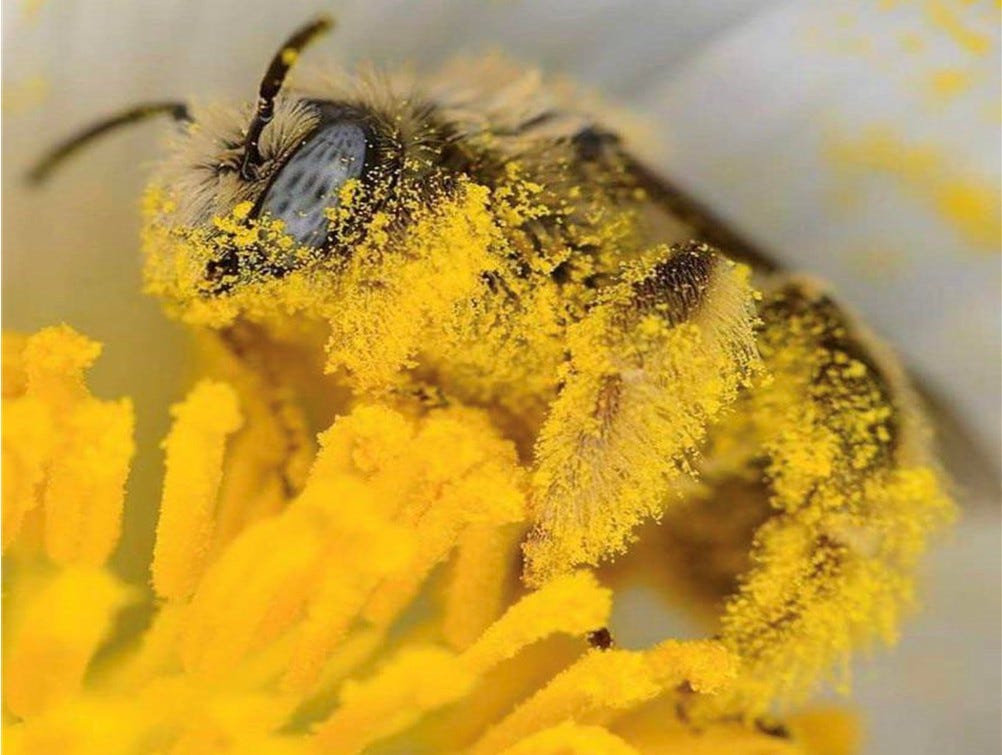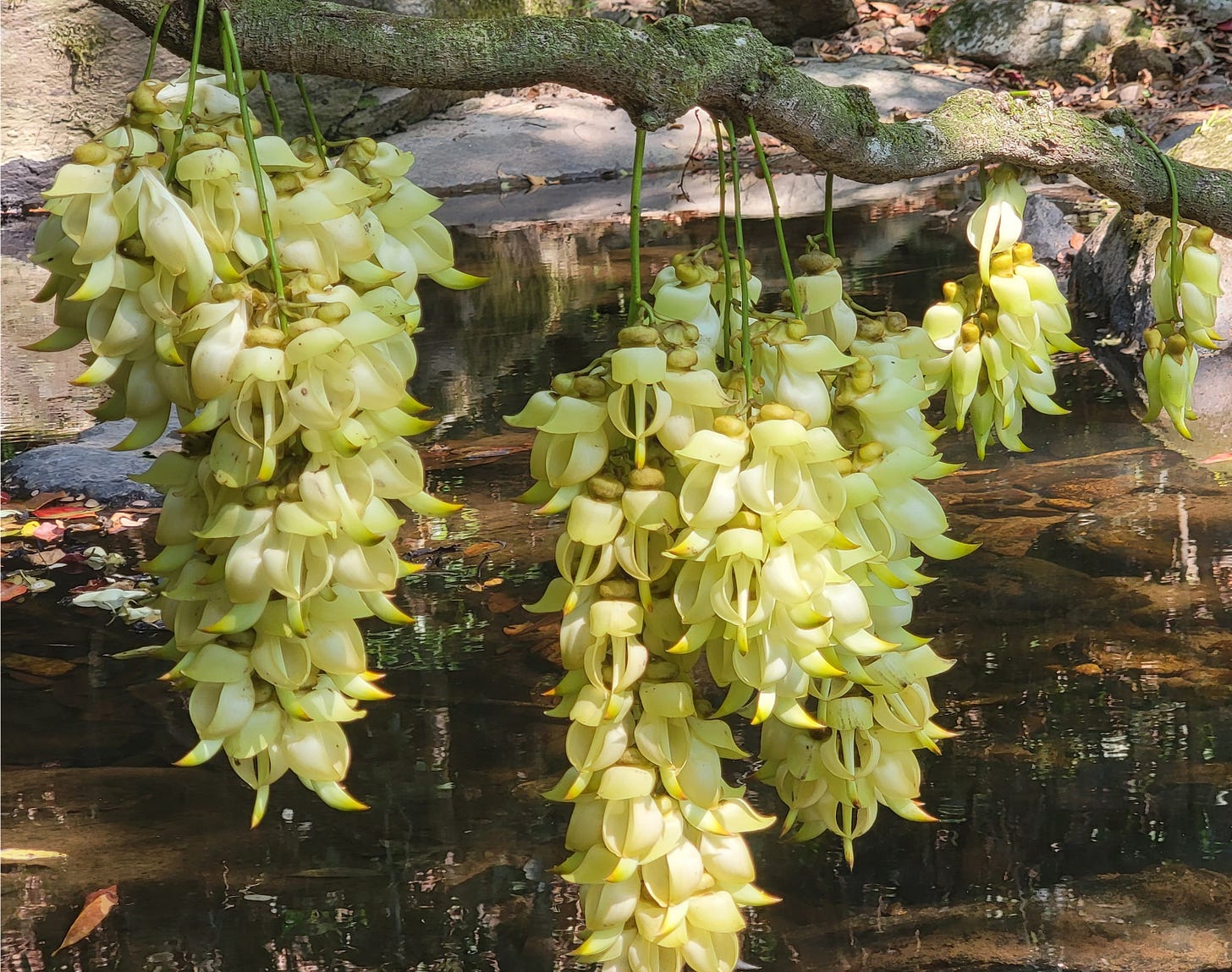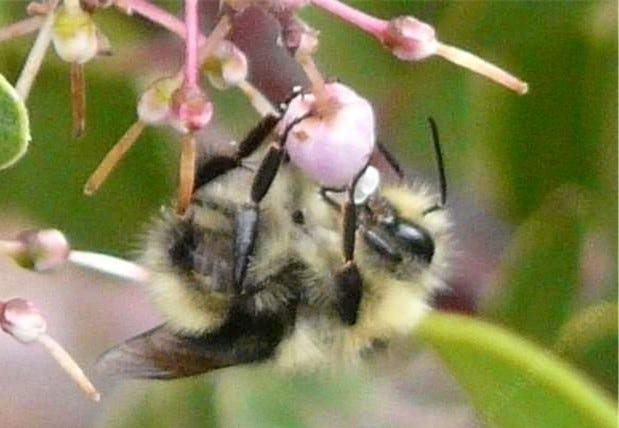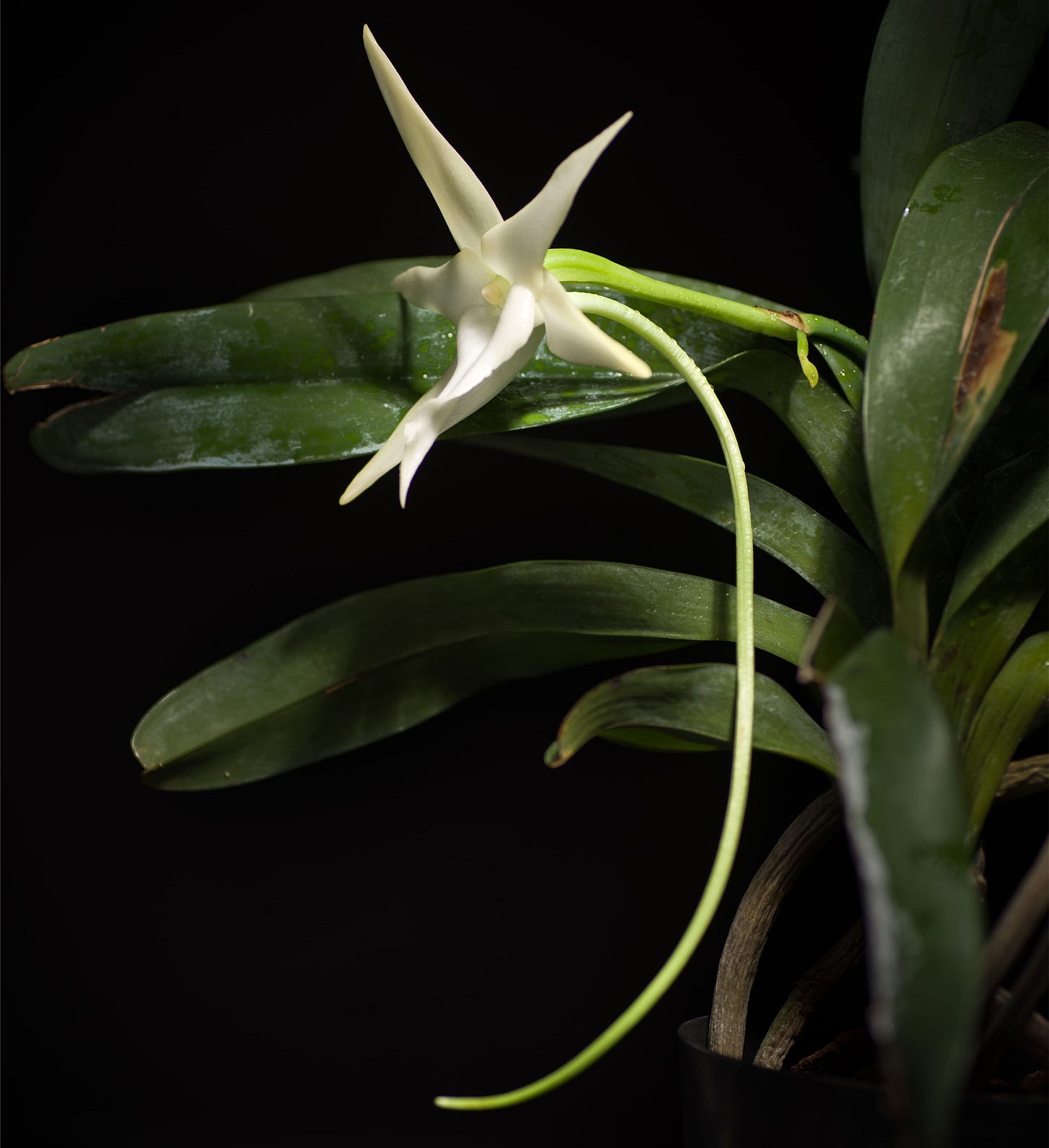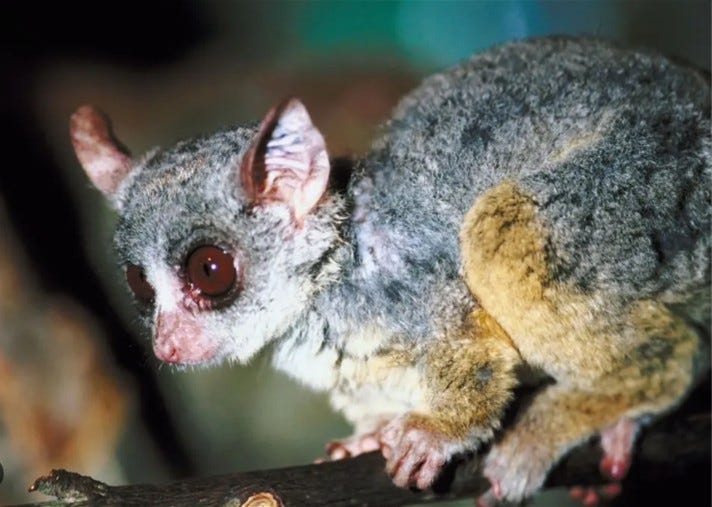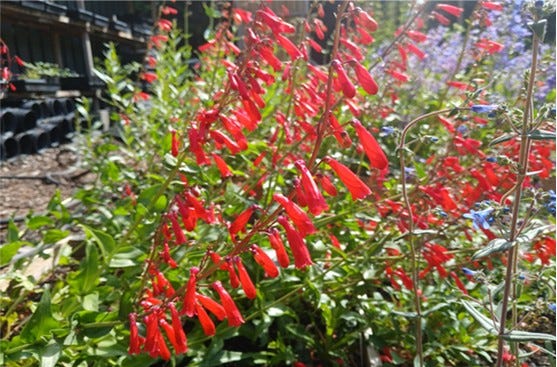One More Time with RANDOM BITS OF “DID YOU KNOW”
Volume 6 -- The One About Pollinators
I admit that maybe I’m having too much fun with these “random bits.” I’ve written several articles, some with minor mention of pollinators, some with more important mention. They left me with some of the “bits and bobs” that make for articles like this one. And then, of course, I had to rabbit-hole a few of the bits. And maybe the bobs. So, if anyone is growing Mucuna birdwoodiana and has thought about getting it pollinated, read on to see if maybe you need to introduce masked palm civets into your landscape.
Whether you have a Mucuna or not, there’s plenty here for those who want to know the deeper and more funner facts about the critters that make fruits, seeds, and eventually more flowers possible for us and for Mother Earth.
Pollination is an ancient partnership. Plants and pollinators have coexisted for millions of years with fossil evidence dating back nearly 99 million years.
Have you ever wondered what the first pollinator was? New evidence suggests it was a small, winged, earwig-like insect known as a tillyardembiid. The fossil record shows this insect with pollen from gymnosperms (conifers) attached to its body. This finding contradicts what was previously thought: that pollinators did not evolve until flowering plants did.
Pollination words. Plants have evolved two primary reproductive strategies: self-pollination for reproductive assurance and cross-pollination to create essential genetic diversity.
Self-pollination occurs either within a single flower (autogamy) or between different flowers on the same plant (geitonogamy).
Many self-pollinators have clever adaptations including cleistogamy, where flowers remain closed to guarantee self-fertilization, a strategy used by crops such as peas and soybeans. The key advantage is reproductive assurance, which guarantees seed production even when pollinators are scarce.Cross-pollination, in contrast, requires a vector such as wind (anemophily) for grasses or animals (zoophily) attracted by colorful, scented flowers.
The timing of native bees and native plants is a synchronized relationship where bees emerge when their food sources, the native plants, begin to bloom. That’s just part of “coevolution,” the process where two or more species influence each other’s evolutionary path, leading to reciprocal adaptations. Many native bees are specialized and rely on specific plants, so their lifecycle is tied to that plant’s blooming period. Is dandelion critical to the survival of bee species in early spring? Nope; not in the U.S. anyway.
Not all pollinators are equal in their pollinating ability. Take butterflies and bumblebees, for example. Butterflies do pick up some pollen while feasting, but their long legs keep their bodies away from the flower and pollen itself, which makes pollen less likely to stick to them. They’re also solitary insects (no hive-mates, no babies in the nest), so they need to forage only enough to sustain themselves.
Bumblebees have shorter tongues and legs, which means they end up coming into more direct contact with the flower and the pollen-producing anthers. They usually stuff their entire bodies into flowers to reach the nectar and pollen. Plus, their bodies are extensively bristly — primed for picking up and holding onto pollen. Finally they are “eusocial,” which means they are social and living in colonies with other bumblebees to take care of; because of that, they have to forage farther and longer than solitary species, to gather pollen from many different plants.
Can flowers “hear” buzzing bees? Not exactly, but they do “respond” to the stimuli of the vibrations from the buzzing sound. Humans work kinda the same way, except we call our translation of vibrations via the ear “hearing.” The plants’ response is to produce more honey with the honey also being sweeter.
Buzz pollination is technically called sonication and is used by bumblebees and carpenter bees to extract pollen from certain flowers that hold tightly onto their pollen grains. These bees grab onto the flower and rapidly vibrate (up to 30 G’s) their flight muscles, causing the flower to release its pollen, which is then collected by the bee who also leaves behind enough of the drifting pollen to pollinate the plant.
Arctostaphylos is one of many primarily American indigenous plants that have flowers built for native bees for pollination. The introduced European honey bees (Apis mellifera) can’t do it because they can’t “sonicate.”When Charles Darwin first looked at Angraecum sesquipedale, an orchid from Madagascar noted for its long spur (with nectar at the very back-bottom), he conjectured that the flower must be pollinated by a then undiscovered moth with a proboscis whose length was unprecedented at the time. The long-mouthed moth was discovered in 1903, twenty-one years after Darwin’s death.
Pollinators make up a significant portion of the total diversity of species on this planet. In fact, between 200,000 and 300,000 invertebrate species — the butterflies, beetles, moths, flies, mosquitoes, and bees — are estimated to serve globally as pollinators.
We know the common pollinators: bees, butterflies, flies, moths, beetles, ants, and everyone’s favorite, bats. But many other critters do the job of carrying pollen around from plant to plant. For instance, skinks, a group of lizards with small legs, crawl about various flower plants, primarily in island nations, carrying pollen stuck to their scales. Geckos, too, are the pollinating lizards of jungle and desert ecosystems. We now know that a Brazilian tree frog accidentally (but significantly) pollinates the same flowers it consumes.
Some spider species — such as jumping spiders and crab spiders — are ambush predators who spend their days lurking in and among flowers in search of their next meal. But as they roam from one bloom to another, they inadvertently pick up and transfer pollen, aiding in pollination of many plants.
Some of the more interesting groups of invertebrate pollinators:
The larvae and adults of tiny ocean crustaceans carry mucilaginous masses of pollen from one sea grass to another.
In at least three countries, cockroaches have been observed serving the role of pollinator.
Mosquitos, specifically the males, are pollen feeders and stray pollen stuck on their feet is a collateral part of the job.
There are also around 2,000 vertebrate species — including birds, mammals, and reptiles — that do the job of pollinating. Those who’ve really jumped into the subject of pollinators have run across the fact that bats are as nifty at the pollen transporting role as are insects. But did you know that there’s quite the collection of mammals, beyond bats, that fill this important position?
Bush babies (or galagos; several species of small, cute, primitive primates ) are an important pollinator of baobabs (large ancient trees native to Africa).
The Namaqua rock mouse (Aethomys namaquensis) feeds on nectar of many plants, including pagoda lilies (Massonia bifolia) in South Africa and, of course, carries pollen from lily to lily.
Certain orchids in China are pollinated by specific rats.
Also in China, in the case of Mucuna birdwoodiana, a woody vine, the primary pollinators are a small, cat-like creature called the masked palm civet (Paguma larvata) and the Pallas’s squirrel (Callosciurus erythraeus styani).
Scientists have only recently encountered Ethiopian Wolves (Canis simensis) enjoying nectar from a large flowering plant.
Plus, there are various lemurs in Madagascar and honey possums and sugar gliders in Australia. We can also add on gerbils, mice, shrews, and other rats.
What, “not in my garden,” you say? Well, you probably do have squirrels, you might have mice (there are many native species in the U.S.), and there’s even some friendly, non-invasive rats.
There’s even a name for this: therophily, which is pollination by non-flying mammals (NFMs).
Hummingbirds can visit up to 1,000 to 2,000 flowers in a single day, making for increased successful pollination opportunities.
Their rapid wing beats create turbulence that can help disperse pollen grains, further aiding pollination.
More than 160 native North American plants rely on hummingbirds as their exclusive pollinators, making them vital for the reproduction of these species. Some of the native plant species: Cardinal flower (Lobelia cardinalis), Eastern red columbine (Aquilegia canadensis), Coral honeysuckle (Lonicera sempervirens), many Penstemon species, some Salvia species, Scarlet gilia (Ipomopsis aggregata), and Royal catchfly (Silene regia).
There are 366 recognized species of hummingbirds, all belonging to the family Trochilidae. All hummingbird species are native to the Americas, with the greatest diversity found in the tropical regions of Central and South America.
The length and curvature of a hummingbird’s beak can be specifically adapted to the shape of the flowers it visits, creating an intricate, specialized relationship. The Sword-billed Hummingbird (Ensifera ensifera) has the longest beak of any bird, in proportion to its body. Its beak, which can measure up to 4.7 inches, is longer than the rest of its body and allows it to feed from very long, tubular flowers.
This species feeds almost exclusively on the nectar of long-tubed flowers with which it has co-evolved, including flowers from the genera Aethanthus, Brugmansia, Datura, Fuchsia, Salpichroa, Solanum, and various species of Passiflora (especially P. mixta and P. pinnatistiplua).
In South Africa, the main pollinating birds are Sunbirds and Sugarbirds, which have coevolved with certain flowers and, just as with hummingbirds, now use their extra-long bills and tongues in the act of pollen transfer. A parallel evolution.
In Australia, it’s the Honeyeaters that are the most abundant and important avian pollinators. They are similar to hummingbirds, in that they use their brush-like tongues to extract nectar from flowers, and in the process, pick up pollen to transfer to other flowers. Another case of parallel evolution.
Studies in California’s Central Valley have shown that a suite of three dozen or more native bee species provide pollination services on a single farm and can deliver sufficient pollination even for crops with a “heavy” pollination requirement such as watermelon. In watermelon up to 1,000 grains of pollen must be deposited on each flower within only a few hours to get marketable fruit.
Fireblight is a contagious disease affecting apples, pears, and several other plants within the family Rosaceae. It is caused by the pathogen Erwinia amylovora, a bacteria. Honeybees (and other insects) are attracted to oozing cankers on badly-infected trees and can spread the bacteria to susceptible tissue of other trees by visiting the flowers, where the bacteria enter through the stigma (the female part).
More than 22 percent of native pollinators in North America are at an elevated risk of extinction. That’s nearly 1,600 species — including bees, beetles, butterflies, moths, flower flies, bats, and hummingbirds. That’s more than one in five and probably closer to one in four.
.
Finally, here’s a couple pieces of data to close:
Pollinators give us about a third or so of the calories we consume (the other two-thirds are the wind-pollinated grains and carbs such as corn, wheat, and rice as well as vegetatively-propagated tuber crops and self-pollinating fruits). But yes, you would be without chocolate if pollinators were gone!
Pollinators are responsible for the continued existence and proliferation of around 80 percent of wild, native plants.
It’s this last one, the detail that rarely gets mentioned along with the food part, that bothers me more.
.
.
© Copyright Joe Seals, 2025


